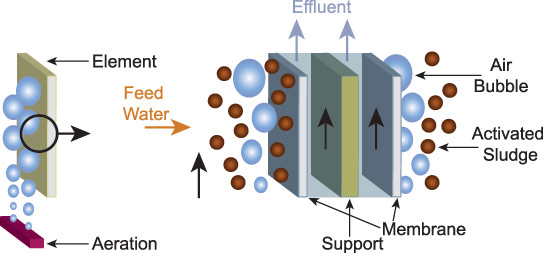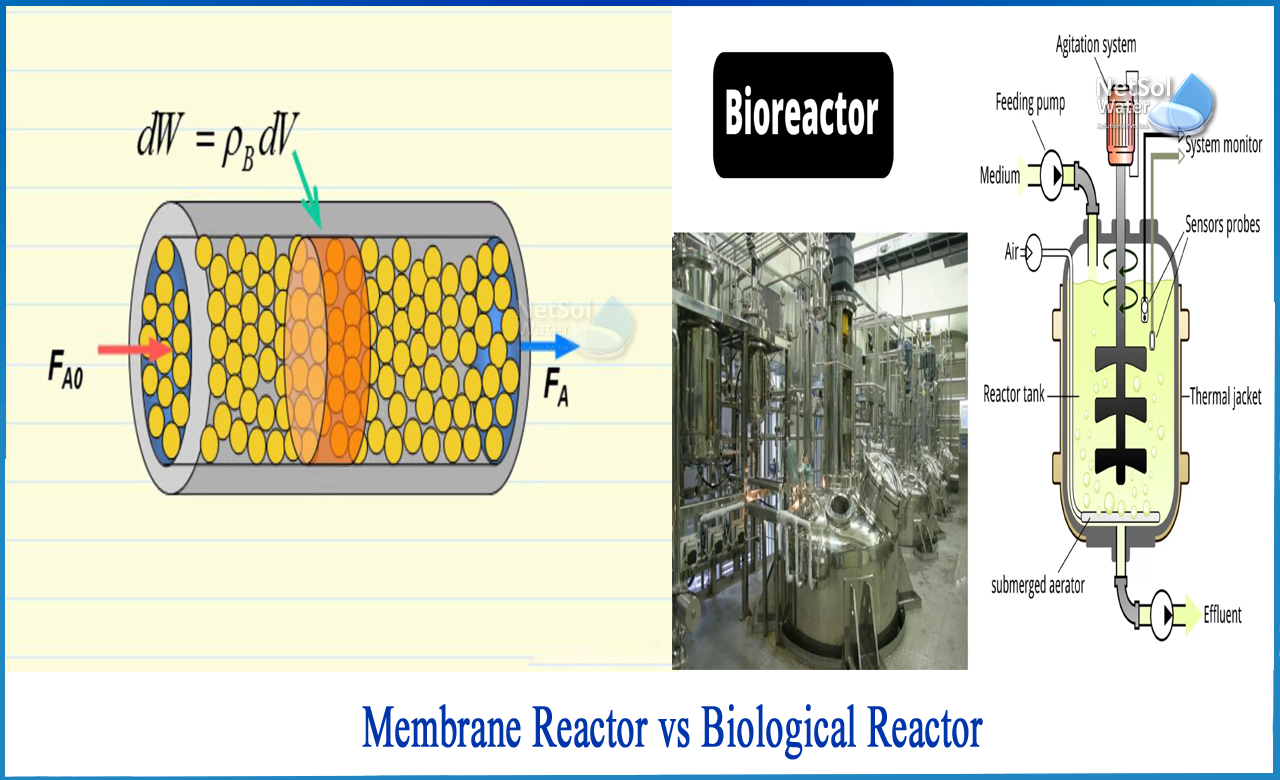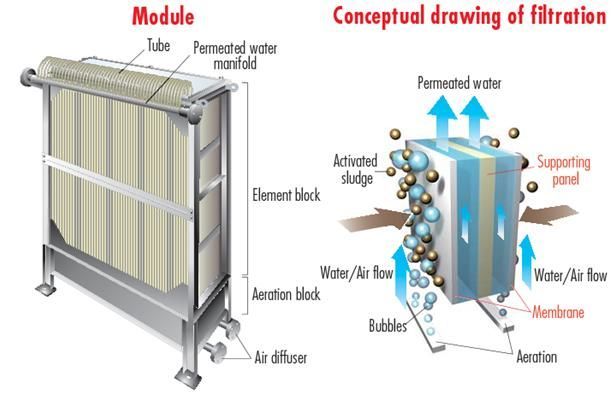Exploring the Benefits of Membrane Bioreactor in Municipal Wastewater Plants
Wiki Article
Just How Membrane Layer Bioreactors Are Transforming Water Purification Solutions
The development of membrane bioreactors (MBRs) stands for a considerable development in the field of water filtration, merging biological therapy processes with advanced membrane filtration modern technologies. As global water deficiency intensifies, the function of MBRs in facilitating potable water reuse and lasting water monitoring becomes increasingly vital.Summary of Membrane Bioreactors
Membrane layer bioreactors (MBRs) represent a considerable innovation in water filtration innovation, as they integrate biological treatment procedures with membrane layer filtering. This assimilation boosts the performance of wastewater therapy by utilizing microbes to weaken organic toxins while at the same time employing semi-permeable membranes to different cured water from put on hold pathogens and solids.The MBR system normally contains a biological activator where the microbial population metabolizes contaminants, complied with by a membrane layer filtration device that keeps biomass and enables only tidy water to travel through. This twin capability causes greater effluent quality compared to standard therapy approaches. MBRs can be operated in both set and continuous circulation modes, providing flexibility in design and application.
In Addition, MBRs are defined by their compact footprint, making them ideal for metropolitan setups with room constraints. Membrane Bioreactor. They additionally enable the recovery of water for reuse, thus adding to water sustainability initiatives. While MBR technology has gotten appeal in metropolitan and commercial applications, its operational complexities and power needs demand cautious factor to consider throughout execution. Generally, MBRs go to the center of boosting water treatment effectiveness and high quality, showcasing the possibility for ingenious remedies in environmental monitoring.
Benefits of MBR Technology
The integration of biological treatment with membrane filtering offers many advantages for water purification procedures. Among the key benefits of Membrane layer Bioreactor (MBR) innovation is its capability to efficiently remove both natural and not natural pollutants, bring about top quality effluent. The membranes act as a physical barrier, avoiding put on hold solids and virus from passing through, which boosts the total safety and dependability of cured water.Furthermore, MBR systems need a smaller sized impact contrasted to conventional therapy methods, permitting much more reliable room usage. This small style is specifically beneficial in urban setups where land is limited. MBRs additionally demonstrate functional flexibility, suiting varying influent high qualities and circulation prices without significant efficiency deterioration.
Furthermore, the procedure uses enhanced nutrient removal capabilities, particularly for nitrogen and phosphorus, which are vital for avoiding eutrophication in receiving waters. The decreased sludge production related to MBR technology additionally converts to lower disposal prices, making it an affordable remedy over time - Membrane Bioreactor. On the whole, the benefits of MBR innovation position it as a leading option for cutting-edge and lasting water filtration systems, addressing both environmental and economic problems
Applications in Water Filtration
Applications of Membrane Bioreactor (MBR) innovation in water purification are impactful and varied, addressing numerous therapy needs across several industries. MBRs successfully incorporate biological therapy procedures with membrane filtering, making them optimal for community wastewater treatment, commercial effluent administration, and also potable water reuse campaigns.In local settings, MBRs are progressively employed to boost the high quality of treated wastewater, enabling for conformity with rigid discharge laws and facilitating the recycling of water for irrigation and non-potable uses. Their portable design also makes them suitable for city settings where room is limited.
Industrially, MBR innovation is used to deal with procedure water and wastewater, especially in fields such as food and beverage, pharmaceuticals, and fabrics. By successfully removing contaminants and put on hold solids, MBRs assist sectors reduce environmental influences while recovering valuable resources from wastewater streams.
In Addition, MBRs are gaining traction in decentralized water treatment applications, where small systems can be released in remote areas or establishing regions. This adaptability allows areas to achieve lasting water administration solutions, boosting accessibility to tidy water while lowering reliance on typical treatment methods.
Situation Research Studies and Success Stories

In another instance, a fabric production facility in Bangladesh embraced MBR technology to address its wastewater difficulties. The system decreased chemical oxygen need (COD) levels from 1,200 mg/L to much less than 100 mg/L, hence satisfying regulative requirements and dramatically lessening environmental influence.
The University of Cape Community's MBR installation has confirmed efficient in treating greywater for non-potable reuse on university. This project not just saves drinkable water but also acts as an educational design for sustainable methods.
Furthermore, a fish and shellfish processing plant in Norway made use of MBR technology to deal with effluents consisting of high check this site out levels of natural matter, accomplishing over 90% toxin elimination. These study underscore MBR innovation's flexibility and its vital role in boosting water high quality throughout varied applications.
Future of Water Therapy Solutions
As global water shortage and contamination challenges heighten, cutting-edge water treatment remedies are ending up being increasingly vital to make certain sustainable access to tidy water. The future of water therapy lies in the assimilation of innovative modern technologies that enhance the performance and efficiency of my sources purification processes. Membrane bioreactors (MBRs) are at the leading edge of this evolution, combining organic therapy with membrane filtration to create top notch effluent appropriate for various applications.
Emerging fads such as source recuperation from wastewater, consisting of nutrients and power, will certainly further transform therapy centers into green hubs. Advancements in nanotechnology and membrane layer materials assure enhanced performance and longevity of filtering systems.

Final Thought
In verdict, membrane layer bioreactors represent a significant advancement in water purification modern technologies, successfully incorporating organic therapy with innovative membrane purification. The numerous advantages, consisting of boosted effluent high quality and minimized spatial needs, make MBRs specifically appropriate for city applications. Their role in safe and clean water reuse and lasting water management highlights their significance in resolving worldwide water shortage difficulties. Proceeded r & d will additionally boost the efficacy and adoption of MBR technology, making certain a resistant future for water treatment solutions.The development of membrane bioreactors (MBRs) represents a significant development in the additional resources field of water purification, merging organic therapy procedures with advanced membrane layer filtration modern technologies. As global water shortage increases, the role of MBRs in assisting in drinkable water reuse and sustainable water monitoring comes to be progressively essential. They likewise allow the recovery of water for reuse, hence adding to water sustainability efforts.As worldwide water shortage and contamination obstacles increase, cutting-edge water therapy services are coming to be increasingly important to make certain sustainable accessibility to tidy water. Their role in potable water reuse and lasting water management highlights their significance in resolving worldwide water scarcity difficulties.
Report this wiki page